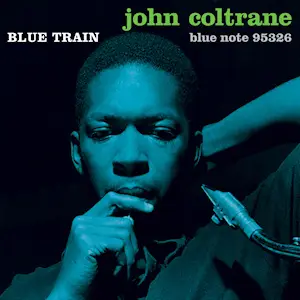Navigating the Sonic Rails:
A Deep Dive into John Coltrane’s Blue Train
In the vast and ever-evolving landscape of jazz, certain albums stand as timeless monuments, showcasing the brilliance of their creators and leaving an indelible mark on the genre. One such masterpiece is John Coltrane’s “Blue Train“. Released in 1957 on Blue Note Records, this album is a sonic journey that continues to captivate and inspire jazz enthusiasts and musicians alike. In this blog post, we’ll delve into the recording process, the exceptional band members, and why every aspiring jazz musician should consider studying each song on “Blue Train.” Discover our free jazz lessons !
Playlist
The recording session:
“Blue Train” was recorded on September 15, 1957, at the Van Gelder Studio in Hackensack, New Jersey. The legendary Rudy Van Gelder, known for his innovative recording techniques, captured the magic of the session. The album’s title track, “Blue Train,” showcases the exceptional chemistry and virtuosity of the ensemble.
The band:
Coltrane assembled a stellar cast of musicians for this iconic recording, each contributing their unique talents to the album’s overall brilliance:
-
John Coltrane (tenor saxophone): The visionary leader and saxophonist, Coltrane’s playing on “Blue Train” demonstrates his signature style—a perfect blend of technical mastery, emotional depth, and relentless innovation.
-
Lee Morgan (trumpet): At just 19 years old during the recording, Morgan’s fiery and lyrical trumpet work added a youthful exuberance to the ensemble. His solos on tracks like “Moments Notice” are a testament to his prodigious talent.
-
Curtis Fuller (trombone): Fuller’s rich, warm trombone tones provided a lush counterpoint to Coltrane’s saxophone. His contributions to the album’s arrangements are pivotal, creating a distinctive sound that sets “Blue Train” apart.
-
Kenny Drew (piano): Drew’s nimble and harmonically adventurous piano playing added a dynamic layer to the album. His intricate solos on tracks like “Locomotion” showcase his versatility and creative prowess.
-
Paul Chambers (bass): Chambers’ bass lines provide a solid foundation for the entire album, anchoring the ensemble with a deep, resonant groove. His collaboration with drummer Philly Joe Jones forms the album’s rhythmic backbone.
-
Philly Joe Jones (drums): Known for his innovative drumming techniques, Jones’s contributions to “Blue Train” are exceptional. His rhythmic interplay with Chambers creates a pulsating energy that drives the album forward.
For jazz musicians looking to hone their craft, “Blue Train” is a treasure trove of inspiration and musical lessons. Coltrane’s innovative improvisations, the tight interplay between band members, and the sophisticated arrangements make each track a valuable study in jazz theory and performance.
The repertoire:
“Blue Train“: The eponymous title track sets the stage with its iconic blues riff and propels the listener into a dynamic journey of improvisation. Coltrane’s tenor saxophone takes center stage, showcasing his technical prowess and emotional depth in a breathtaking single take. A lot of great ideas to steal from his solo!
“Moment’s Notice“: This composition is a whirlwind of rapid-fire changes. Lee Morgan’s trumpet and Curtis Fuller’s trombone engage in a spirited conversation, while Coltrane’s saxophone explores the harmonic complexities with virtuosic flair. A great tune to practice contiguous II Vs!
“Locomotion“: As the rhythmic engine of the album, “Locomotion” lives up to its name. Kenny Drew’s piano provides a pulsating backdrop, and Philly Joe Jones’ drumming, alongside Paul Chambers’ bass, creates a propulsive groove. Coltrane’s saxophone weaves through the rhythmic landscape with improvisational brilliance. This composition is an AABA form where the A is a blues and the B an 8-bar section with chromatic dominants descending from the subV7/VI to the V7.
“I’m Old Fashioned“: Offering a moment of respite, this ballad showcases is the only tune not composed by Coltrane. The ensemble’s interpretation of the Jerome Kern standard is both nostalgic and innovative, with each musician contributing to a lush and emotive sonic tapestry. Great standard that presents a couple of challenges: 36-bar ABCD form with a modulation to the third degree in the C section.
“Lazy Bird“: Closing the album with a flourish, “Lazy Bird” is a tour de force of bebop and hard bop. Coltrane’s saxophone soars through intricate lines, and the ensemble engages in a spirited exchange, bringing “Blue Train” to a triumphant conclusion. The track serves as a testament to the collective brilliance of the musicians involved, leaving an indelible mark on the listener’s musical soul. Another tune to study contiguous II Vs and great solo analysis!
Conclusion:
To fully grasp the nuances of “Blue Train,” consider investing some time and break down each song. In our lessons, you will find invaluable insights into the techniques employed by Coltrane and his ensemble. Whether you’re an aspiring saxophonist, trumpeter, pianist, or any other jazz instrumentalist, delving into the intricacies of “Blue Train” can elevate your understanding of jazz improvisation and ensemble dynamics.
“Blue Train” remains a landmark album in the history of jazz, a testament to the genius of John Coltrane and his ensemble. Studying each song on this album offers aspiring jazz musicians an opportunity to not only appreciate the masterful performances but also to glean insights that can enhance their own musical journeys. So, hop on board, take the musical journey, and let the timeless sounds of “Blue Train” inspire and guide you as you navigate the intricate rails of jazz improvisation.
Learn better with the JVL pedagogy
Each course (available in English and French) is a deep analysis of each track: Blue Train, Moment’s Notice, Locomotion, I’m Old Fashioned and Lazy Bird.
Each lesson includes PDFs with harmonic and melodic analysis, technique exercises, improvisation techniques, solos analysis and more for you to learn better and get you inspired to practice and play!
"Blue Train" live concert:
Alex Terrier: alto and soprano saxophone
Franck Avitabile: piano
Thomas Bramerie: bass
Olivier Robin: drums







One Response